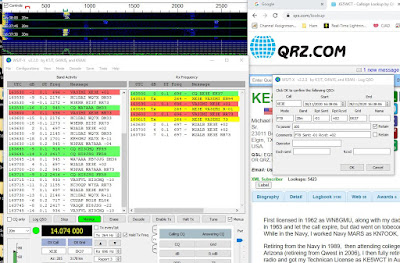Built an 80m Inv V ( apex 30', ends 10' ) aka Near Vertical Incident Skywave Antenna...NVIS.
I also have and love an 80m Vertical aka inverted L ( 30' Vertical , 30 ' Horizontal ) I call this my Vertical antenna.
The idea behind the NVIS is to have better signals in close for " local " use ...say under 500 km.
I have compared both antennas doing simultaneous WSPRs , both day and night. The easiest way at a glance to see the results is the map below...
DAY TEST
Noon to 1pm local - Both stations were transmitting 200 mw or if you prefer +23 dbw +/- 2 db.
BLACK DOT - My QTH
RED DOTS - The 80m Vertical
BLUE DOT - The 80m NVIS
GREEN DOTS - Both WSPRs received.
There are a few variables but its obviously clear that the NVIS is doing what its suppose to do and teh vertical is also performing as expected. Now keep in mind this was done between Noon and 1 pm so the D Layer is full tilt!
Here is the data from stations receiving both the NVIS and Vertical transmissions at the same time.
Click on the image to make it large
NOTE VE3LDP is the NVIS
VA3IMI is the Vertical
DIF is NVIS - Vertical
There is not much difference when you get under 300 km but going out 375 km the signals from the Vertical are 3 to 7 db better ... thats huge!
The closets reception reports was the one and only blue dot 116 km from me and this station only heard the NVIS antenna.
In conclusion the signals in close really were not all that much different then on either antenna. There was a clear advantage for the vertical beyond 300 km.
NIGHT TEST
I was surprised a little but the test was not totally conclusive but close enough.
BLACK DOT - My QTH
RED DOTS - The 80m Vertical
BLUE DOT - The 80m NVIS
GREEN DOTS - Both WSPRs received.
The blue dots through the Midwest are QTHs more or less broadside to the 80 Dipole... makes since as its a 3 db gain in that direction as compared to the vertical.
Here are the simultaneous spots ...
Dipole performed better but make note all the simultaneous spots were from 3 resporters in the US West. The vertical was heard in close < 500 km and then far off > 3000 km. The dipole was more broadside but once you got +/- 45 degrees from SW the vertical was the antenna.
No doubt a little more testing is to be down. There was still pretty good performance off the dipole in spite of it being 30' up at the apex.
NEXT up..lower the APEX and test again.
























































